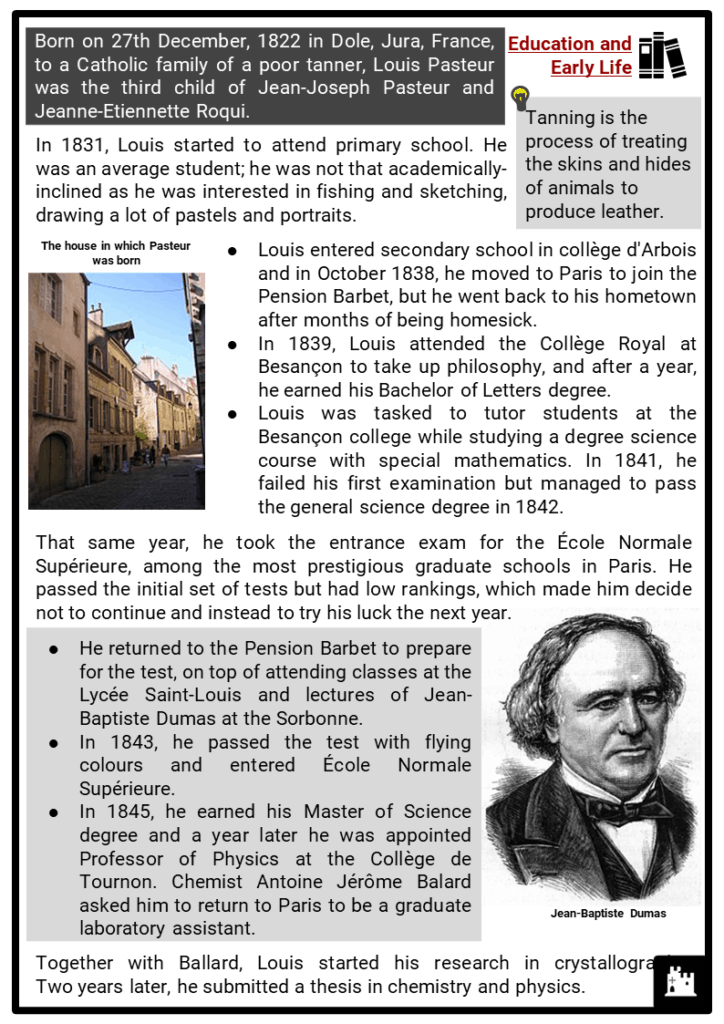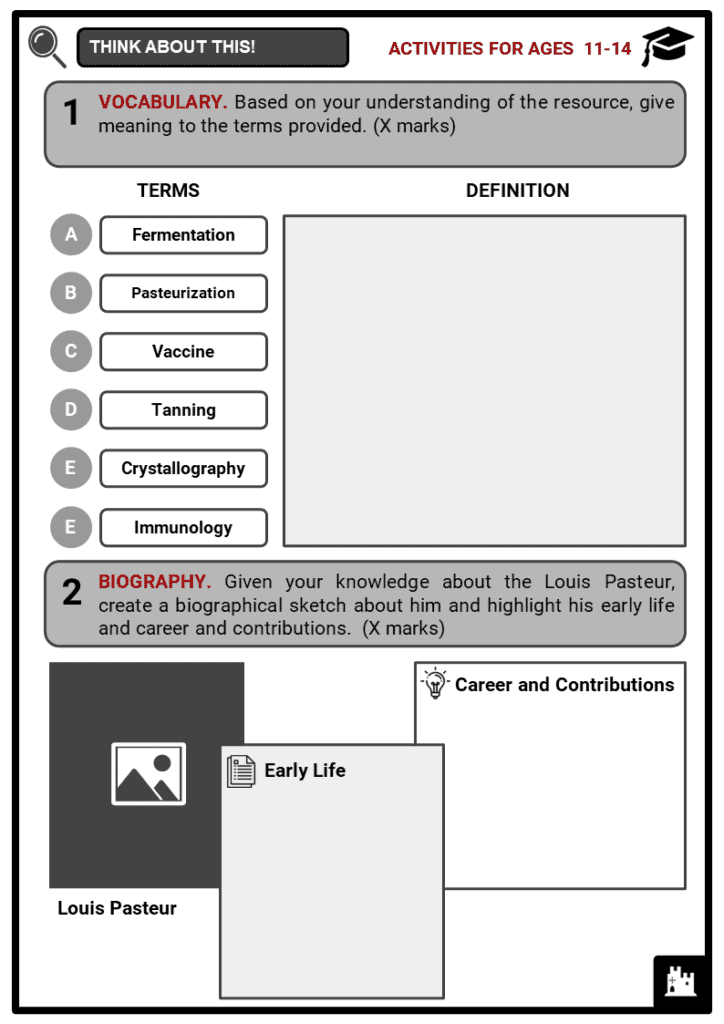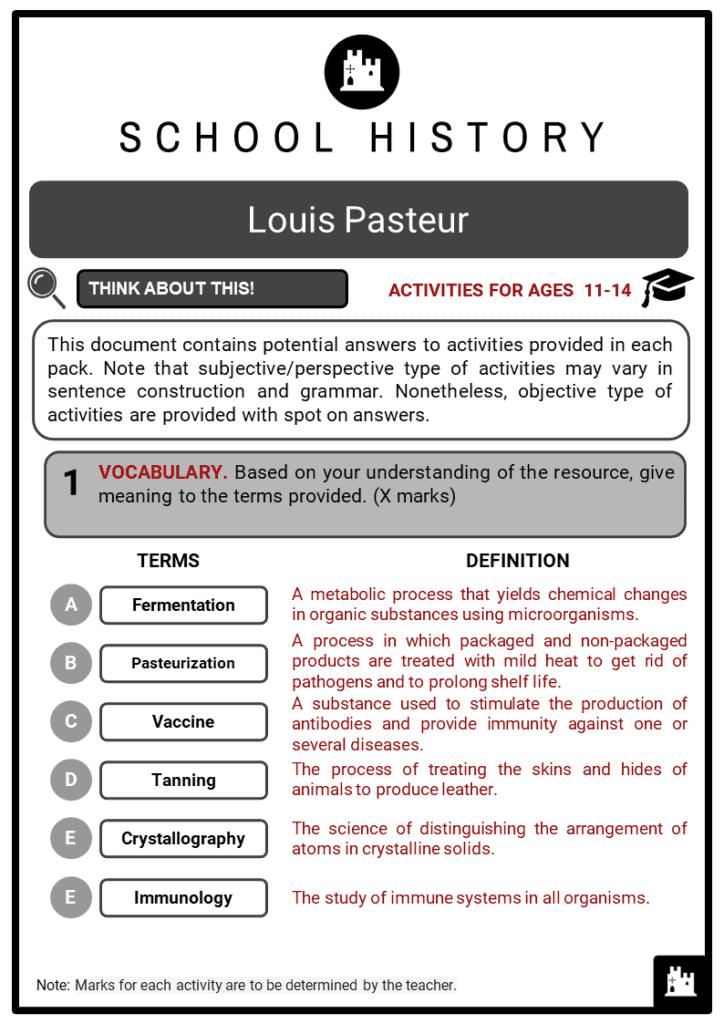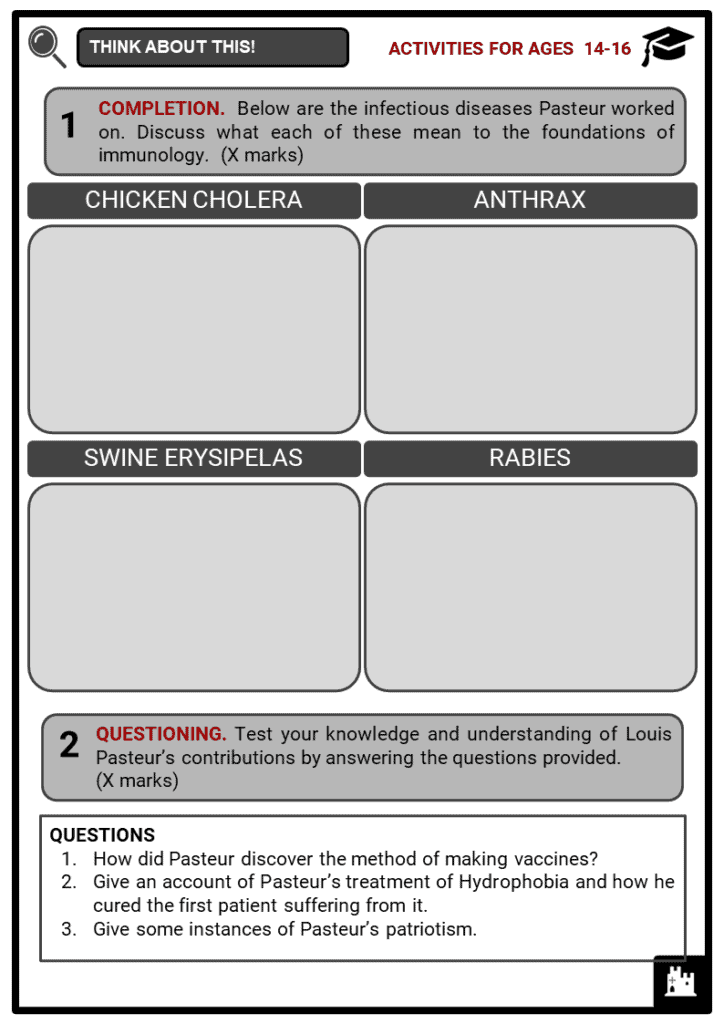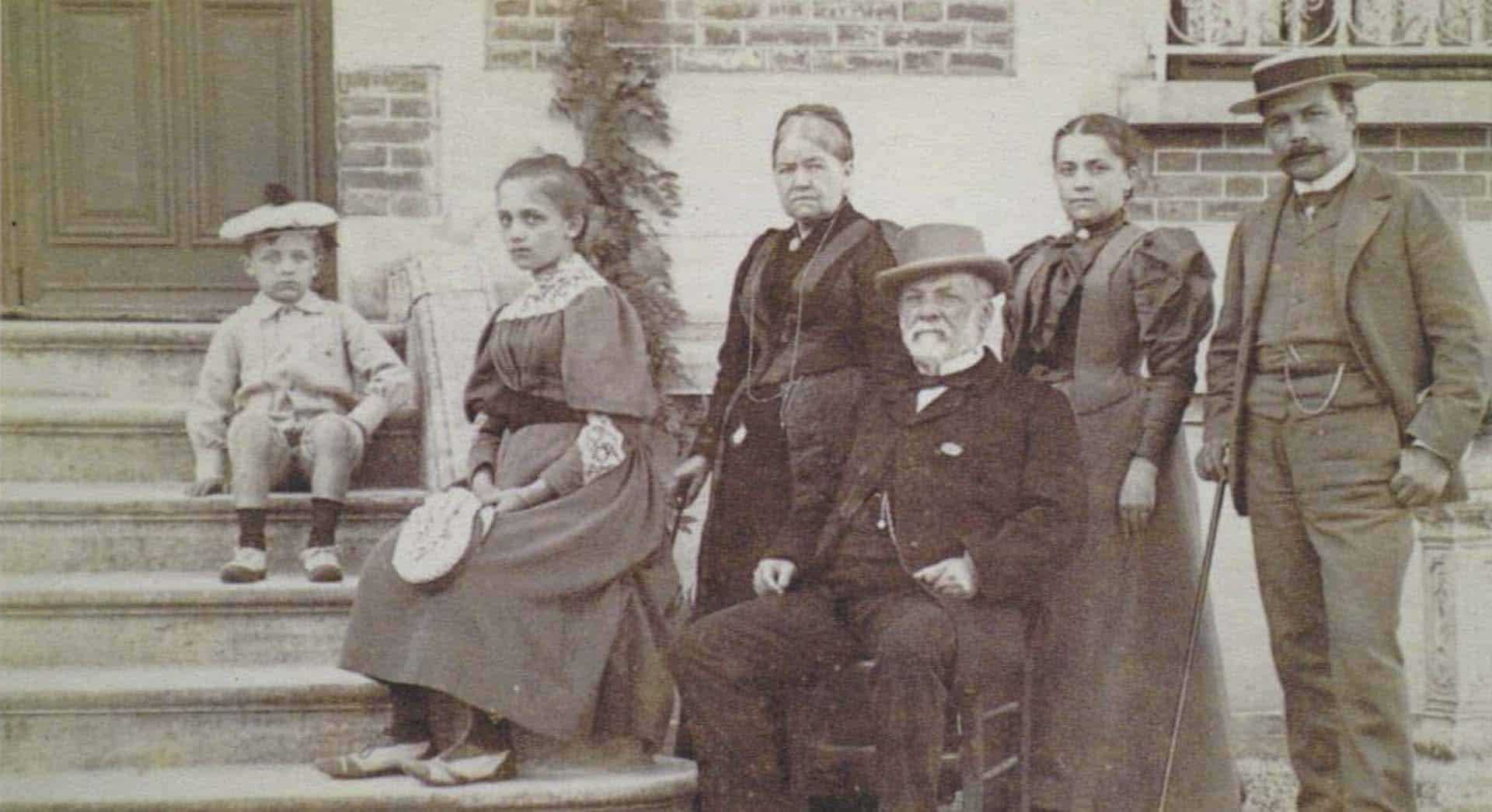Download Louis Pasteur Worksheets
Do you want to save dozens of hours in time? Get your evenings and weekends back? Be able to teach Louis Pasteur to your students?
Our worksheet bundle includes a fact file and printable worksheets and student activities. Perfect for both the classroom and homeschooling!
Table of Contents
Add a header to begin generating the table of contents
Summary
- Early Life
- Career Beginnings
- Discoveries and Scientific Contributions
- Personal Life and Death
Key Facts And Information
Let’s find out more about Louis Pasteur
- Louis Pasteur was a French chemist, founder of microbiology, known primarily for his work on pasteurization of food and on preventive vaccines. Pasteur demonstrated that in reality, each microbe is derived from a pre-existing microbe and spontaneous generation does not occur. He developed techniques to attenuate the virulence of rabid spinal cord infected with rabies, proved that the material so obtained could be used to vaccinate dogs against the disease, and finally treated human beings who had been bitten by rabid dogs. Today, he is often considered as one of the fathers of germ theory. Pasteur was appointed professor of chemistry at the Sorbonne, and was the founder and director of the Pasteur Institute which began in 1889.
Education and Early Life
- Born on 27th December, 1822 in Dole, Jura, France, to a Catholic family of a poor tanner, Louis Pasteur was the third child of Jean-Joseph Pasteur and Jeanne-Etiennette Roqui.
- In 1831, Louis started to attend primary school. He was an average student; he was not that academically-inclined as he was interested in fishing and sketching, drawing a lot of pastels and portraits.
- Louis entered secondary school in collège d'Arbois and in October 1838, he moved to Paris to join the Pension Barbet, but he went back to his hometown after months of being homesick.
- In 1839, Louis attended the Collège Royal at Besançon to take up philosophy, and after a year, he earned his Bachelor of Letters degree.
- Louis was tasked to tutor students at the Besançon college while studying a degree science course with special mathematics. In 1841, he failed his first examination but managed to pass the general science degree in 1842.
- That same year, he took the entrance exam for the École Normale Supérieure, among the most prestigious graduate schools in Paris. He passed the initial set of tests but had low rankings, which made him decide not to continue and instead to try his luck the next year.
- He returned to the Pension Barbet to prepare for the test, on top of attending classes at the Lycée Saint-Louis and lectures of Jean-Baptiste Dumas at the Sorbonne.
- In 1843, he passed the test with flying colours and entered École Normale Supérieure.
- In 1845, he earned his Master of Science degree and a year later he was appointed Professor of Physics at the Collège de Tournon. Chemist Antoine Jérôme Balard asked him to return to Paris to be a graduate laboratory assistant.
- Together with Ballard, Louis started his research in crystallography.
Two years later, he submitted a thesis in chemistry and physics. - After being appointed Professor of Physics at the Dijon Lycée in 1848, Louis became a Professor of Chemistry at the University of Strasbourg, where he met Marie Laurent - the daughter of the university’s rector.
- On May 29, 1849, Louis and Marie got married, and together they had five children, only two of whom survived to adulthood; the other three were plagued by typhoid fever.
- Louis introduced a number of reforms to improve and develop the standards of scientific work, having more rigid examinations which yield to better results, greater competition, and increased prestige.
Career Beginnings
- Louis introduced a number of reforms to improve and develop the standards of scientific work, having more rigid examinations which yield to better results, greater competition, and increased prestige.
- École Normale Supérieure was initially established during the French Revolution.
- After his service as a Professor of Chemistry at the University of Strasbourg, he was appointed Chair of Chemistry in 1852.
- Two years later, he became the Dean of the new Faculty of Sciences at the University of Lille, where he started his research on fermentation.
- In 1857, he departed for Paris to serve as the Director of Scientific Studies at the École Normale Supérieure, where he took control from 1858 to 1867.
- Most of his rules were rigid and authoritarian, resulting in two serious student revolts. During the “bean revolt”, he proposed that a mutton stew, which students refused to consume, would be served and eaten every Monday. He also threatened to expel any student caught smoking. Only 7 of the 80 students stayed in school while the rest resigned.
- In 1863, he became Professor of Geology, Physics, and Chemistry at the École Nationale Supérieure des Beaux-arts, a post that he resigned from after four years.
- In 1867, he was appointed Chair of Organic Chemistry at the Sorbonne, but he gave up the position because of his deteriorating health.
- That same year, the École Normale's Laboratory of Physiological Chemistry was established at his request, and he was the laboratory’s director for 21 years, starting in 1867.
Discoveries and Scientific Contributions
- Louis is remembered for his outstanding breakthroughs and contributions to the causes and preventions of diseases. He is also best known for his invention of the technique of treating milk and wine to avoid bacterial contamination.
- Crystallography is the science of distinguishing the arrangement of atoms in crystalline solids. This came from the Greek words crystallon and graphein.
Molecular Asymmetry
- Pasteur’s first discoveries, made while he was still a student, were in crystallography.
- He discovered molecular asymmetry by separating two crystalline forms of tartaric acid and showing their opposite effects on polarised light.
- Established that isomerism - the existence of two or more substances with the same molecular weight but with different physical or chemical properties - occurs in many organic substances and that natural products occur in only one of the two isomeric forms. They thus differ from molecules produced by chemical synthesis, which are mixtures in equal concentrations of both forms.
- Recognised that living things exhibit selectivity with regard to their chemical action on isometric forms, a fact which prepared his mind for studies on fermentation.
- In Lille, he was consulted by an industrialist who had observed that undesirable products often appeared during the fermentation by which yeast transformed sugars into alcohol.
Microbial Fermentation
- Fermentation is a metabolic process that yields chemical changes in organic substances using microorganisms.
- The theory of fermentation in favour at that time was that yeast acted as a chemical catalyst on this transformation.
- Pasteur’s earlier studies on the production of optically active substances in the course of living processes led him to guess that:
- Yeast was not a chemical catalyst but a microscopic organism
- Conversion of sugar into alcohol was an expression of its biological activity
- He postulated that the undesirable products in alcoholic fermentation came from microscopic organisms different from yeast which had taken the upper hand over the latter.
- Pasteur claimed that each particular type of fermentation was the effect of a specific microorganism - called germs - acting on a specific type of substance to produce another substance.
- In rapid succession, he illustrated this revolutionary theory with brilliant studies on the conversion of:
- Butyric acid is a colourless liquid soluble in water, such as plant oils.
- His germ theory of fermentation was first presented in 1857 in a short paper which has become a classic, Sur la fermentation appelée lactique (On Lactic Fermentation).
- He claimed in his paper the different types of microbes that could be separated from each other by proper techniques and could be shown to differ in nutritional requirements, and susceptibility to antiseptics.
- He suggested, furthermore, that just as each fermentation was caused by a particular type of germ, so it was with many types of disease. Thus, the fundamental tenets of the germ theory of fermentation and of disease were clearly stated in this preliminary paper.
- Certain microorganisms derive energy from reactions which do not make use of oxygen.
- This discovery of anaerobiosis suggested to him that fermentation is the metabolic equivalent of respiration when life is carried out without oxygen.
Spontaneous Generation
- Pasteur became preoccupied with the origin of microorganisms.
- Low forms of life could originate from organic materials during the souring of milk, the fermentation of grape juice, the putrefaction of meat, etc. – a view that implied the spontaneous generation of microbes.
- Each microbe is derived from a pre-existing microbe; thus, spontaneous generation does not occur. Spoilage of perishable products could, therefore, be prevented by destroying the microbes already present and by protecting the sterilised material against subsequent contamination.
- Pasteur applied this theory to the preservation of beverages and foodstuff, introducing thereby the technique of heat treatment, since called pasteurization, which was first applied by him to the treatment of wine.
Germ Theory of Diseases
- In 1865, Pasteur was asked to study the diseases of silkworms that threatened the silk industry in the south of France. He established a primitive laboratory in the mountains where the disease was prevalent. Three years of intensive work revealed two diseases in the silkworms.
- Pébrine
- Also called “pepper disease”
- Caused by protozoan microsporidian parasites
- Infected silkworms are usually covered in brown dots and are unable to weave silkworm thread
- Flacherie
- Literally known as “flaccidness”
- Caused by silkworms eating infected or contaminated mulberry leaves
- Silkworms about to die from this disease are dark brown
- Pasteur worked out techniques for the selection of non-inflected worms and urged other steps for sanitary management of silkworm nurseries which led to rapid improvements in silk production.
Immunology and Vaccination
- Immunology is the study of immune systems in all organisms.
- Over the next decade, Louis Pasteur developed the overall principle of vaccination, researched infectious diseases such as chicken cholera, anthrax, swine erysipelas, and rabies - thus contributing to the foundations of immunology.
- Chicken cholera
- In December 1879, he worked with a weakened culture of bacteria to artificially induce immunity in chickens. The chickens survived, and when he did the procedure again but with a virulent strain, they became immune to it.
- Swine erysipelas
- In March 1883, his assistant, Louis Thuillier, identified the bacillus that caused an epizootic in Southern France. Pasteur and Thuillier scaled the bacillus’ virulence after passing it through pigeons and rabbits; thus, obtaining a vaccine.
- Anthrax
- In the 1870s, Pasteur applied this immunization procedure to anthrax (which plagued cattle). He cultivated bacteria from the blood of infected animals. When he inoculated animals with the bacteria, anthrax took place, suggesting that the bacteria was the cause of the disease. He found out that earthworms have been the carriers of anthrax.
- Rabies
- He created the first vaccine for rabies by growing the virus on rabbits, and then weakening it by drying the infected nerve tissue. In 1886, of the 350 people he treated, only one developed rabies. The treatment’s success built the foundations for the manufacture of several other vaccines. The first Pasteur Institute was also established because of this.
Pasteurization
- Pasteurization is a process in which packaged and non-packaged products, such as dairy and fruit juice, are treated with mild heat, usually lower than 100 °C (212 °F), to get rid of pathogens and to prolong shelf life.
Personal Life and Death
- Pasteur’s devotion to scientific research was complete; despite a stroke which partly paralysed him at the age of forty-six, he worked with incredible intensity.
- In many famous controversies, he overcame his opponents by dramatic and convincing demonstrations. While believing strongly in experimental science, he also maintained that there exist spiritual values that transcend the scientific approach, a thesis which he defended in a celebrated debate with the philosopher Joseph Ernest Renan.
- A stroke or uremia (excessive accumulation of urea in the blood) in 1894 severely affected his health. Failing to recover, Pasteur died in Villeneuve l’Etang, Seine-et-Oise, on September 28, 1895.
Image sources:
[1.] https://upload.wikimedia.org/wikipedia/commons/3/3c/Albert_Edelfelt_-_Louis_Pasteur_-_1885.jpg
[3.] https://upload.wikimedia.org/wikipedia/commons/9/93/PSM_V72_D022_Pasteur_institute_paris.png


